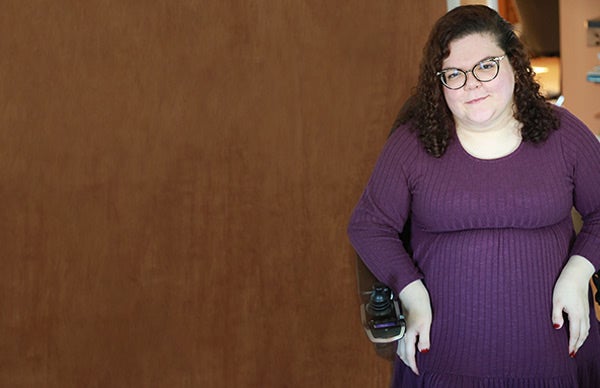
Event planners strive to create accessible events. And beyond making an event accessible, the goal is to create and host an event that is welcoming. To understand how to make events more accessible and successful from a mobility disability standpoint, we chatted with speaker Emily Ladau, author of Demystifying Disability: What to Know, What to Say, and How to Be An Ally and an internationally celebrated disability rights activist, who graciously took us through her experience doing a typical speaking event.
For Ladau and many other speakers with disabilities, preparation starts well before the speaking engagement. “I’m constantly allowing for more time,” she says. “When you are traveling as a disabled person, it is often about planning and giving yourself enough time.” Since she uses a wheelchair, Ladau needs to leave for the airport 5-6 hours early.
Upon arriving there via accessible transportation, she must undergo a complex process to pass security with her wheelchair, make it to the gate, and get on the plane on time, all while disseminating instructions to TSA, gate agents, and ground crew about how to transfer her safely to her seat onboard, tag her wheelchair as luggage and put it in cargo, and ensure they both reach their destination safely. “Once I’m on the plane, I have to hope and pray that my wheelchair does not get damaged and makes it to the other side,” she says.
Assuming all goes well upon arrival (which it sometimes doesn’t), she can begin the process of getting to her accommodations and the event venue. Since wheelchair accessible taxis or ride-share services are rarely available and few hotels have wheelchair-accessible shuttles, Ladau often needs to arrange for medical transportation. “It’s not glamorous, but practical!” she laughs.
Once at the hotel, Ladau often discovers that they haven’t reserved a wheelchair-accessible room for her despite saying they would. And if the hotel doesn’t have a restaurant or room service and she can’t leave to get something to eat as the surrounding area is largely wheelchair-inaccessible, then she has to stay put in her hotel before the event.
“What means a lot to me,” Ladau notes, “is when someone who invites me to speak also considers the accessibility of the area and offers up suggestions for how I might navigate that or what is nearby. I’m not looking for people to pamper me and meet my every need…. It’s just a matter of knowing that everything, the basics, will be accessible to me when I get there.”
Ladau is quick to emphasize that this shouldn’t alienate anyone from wanting to bring someone with a disability to come speak. “Rather, this should be looked at as an opportunity to improve things for everybody,” she says.
Here are 5 tips Ladau shared to create truly accessible events for everyone:
1. Have a conversation with your speaker from the get-go about accessibility needs and build accessibility into your planning process. “This doesn’t have to be a huge undertaking, especially if you make accessibility a priority from the outset of an event,” Ladau says. “It’s something you can make a standardized part of the process. And getting that infrastructure [in place] the first time makes every event better.”
2. Have a point person for accessibility questions. “The common thread running through my best event experiences is there’s always a point person who is there to answer any questions I have in the lead-up, who has made themselves available, and if they don’t know [the answer], rather than making an assumption, they will ask and they will be in communication when it comes to planning. That is really helpful to me,” she notes.
3. Be flexible on format. In-person, hybrid, and virtual options should be considered as “both/and” not “either/or” options. “The ability to be with people in person in the same room is incredibly powerful, and I definitely thrive on that connection,” Ladau says. “But especially in areas where accessibility is incredibly limited, don’t rule out virtual or hybrid as an option, not just for the speaker but for the people attending the event as well.” Bonus: Virtual/hybrid events can sometimes be more cost-effective.
4. Communicate how attendees can request accessibility accommodations. Make sure your event materials and registration clearly convey how attendees can request accommodation or share an accessibility need, such as ASL interpretation, closed captions, wheelchair access, etc.
5. There’s a difference between making an event accessible and making it feel welcoming. Little things go a long way, like ensuring the speaker has everything they need to answer audience questions and participate in pre- and/or post-event activities. Ladau, who is hard of hearing, notes that having closed captions at a large event guarantees she can hear and understand audience questions and thus fully engage with them. “I feel very lucky,” Ladau states. “Because if someone is bringing me in to speak, chances are they want to do their best to be welcoming to people with disabilities anyway. But there are still certain moments where I do find myself feeling like it was more of a hassle to get me there than it was something they are looking forward to and excited about.”
For Ladau, speaking is not only a job but her passion. “When I agree to do a speaking engagement [in person], it is because I am fully committed to that event, because of the amount of effort it takes for me to get from Point A to Point B,” she remarks. “I want to do my best. All I need is an environment in which I can thrive, one that is accessible and safe.”
So when you make an event accessible, you get the ultimate return on your investment: Both speakers and attendees can show up as their best selves and be fully present.